Since its unexpected introduction, I’ve seen a lot of articles and video reviews of the Ruger GP100 in 10mm. I’m not going to mention any names, but many of these have casually mentioned that you can shoot .40 S&W in the 10mm GP100. A couple articles from well-respected outlets have even cited the caliber as “10mm/.40 S&W” in the specifications (Ruger’s own specifications make no such claim).
At the same time, it seems that few of these reviewers have actually tried it. If you share the impression that you can shoot .40 S&W in the 10mm GP100 I might have some bad news for you. I had planned to save this for Part II of my review but I feel like this info needs to get out sooner rather than later.
Dual Caliber Desirability
There are some pretty awesome benefits to being able to shoot both cartridges in one gun, and some specific advantages to shooting the .40 S&W in a 10mm. A lot of these benefits are similar to shooting .38 Special in a .357 wheelgun. First, inexpensive range ammo is lighter than most 10mm loads, letting you practice with really light stuff. If light stuff doesn’t interest you, there are also some stellar .40 S&W defensive loads. After a generation in law enforcement holsters the Forty has gain some serious street cred, and extremely refined bullet designs abound.
Ammo for the shorter round is also cheaper, especially when purchased in bulk. Forty caliber ammo is also much more widely available than the 10mm. Even with the long, slow resurgence of the 10mm, I’m not seeing it behind the counter at my local Wal-Mart. . . but they do have .40. And it just so happens .40 S&W is one round that seemed to weather the ammo drought pretty well. With seemingly everyone standardized on 9mm, .40 has not been hard to find over the last few years. Having a little cartridge flexibility is always a good thing, especially if availability is a concern.
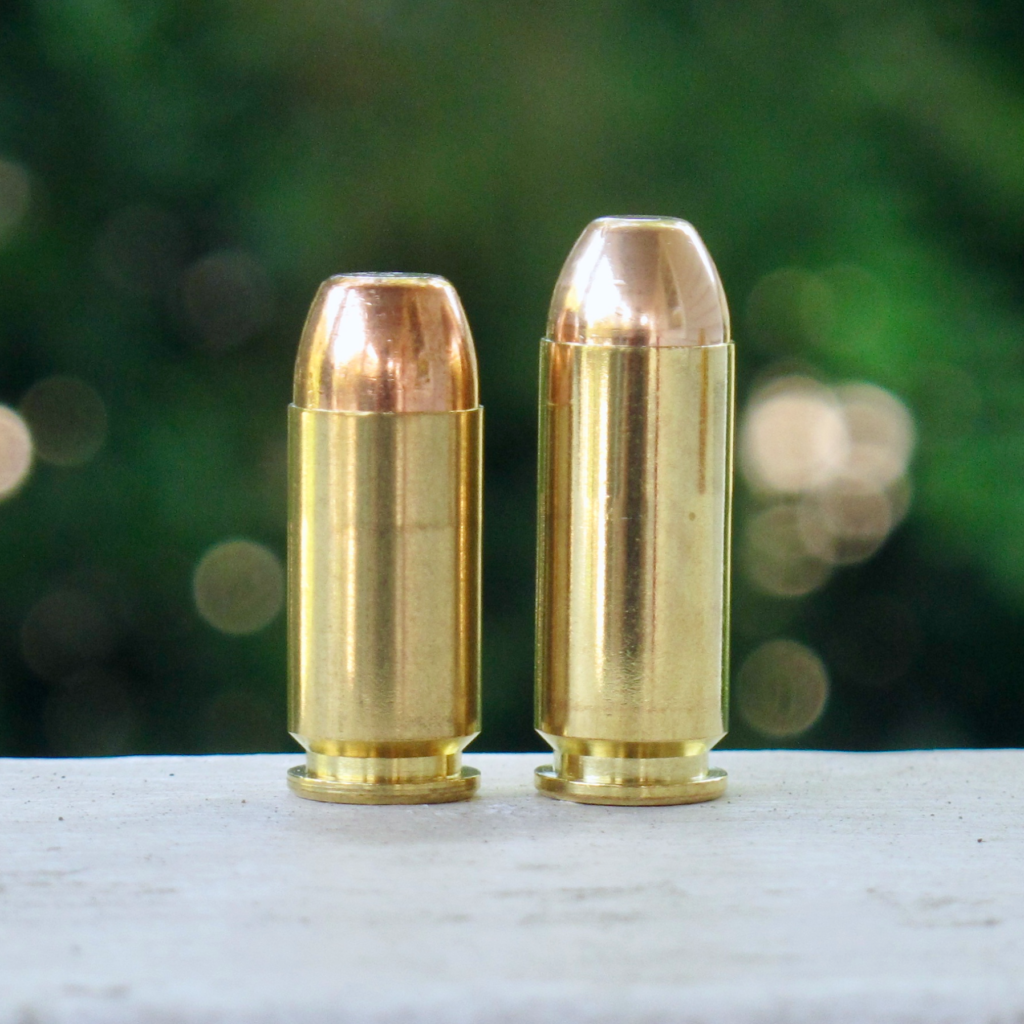
There are also some benefits that are really attractive to competition shooters. The shorter .40 S&W (10×22) cartridge loads a little easier and faster than the longer 10×25. Because the cartridges are shorter and the bullets are closer to the moon clip they are less likely to “droop.” This eases alignment with the chambers and improves overall reload speed. Because they are shorter they also have less travel to seat, making them just a shade faster. The shorter brass also reduces surface area contacting the chamber, which in turn reduces the odds of a round stopping short of fully seating.
10mm GP100 Peculiarities
As I mentioned in my introductory article on this gun, the 10mm GP100 can be fired with or without moon clips. This is possible because the cartridges take their headspaces from the case mouth. The case mouth sits on a small “ledge” inside each chamber. Using moon clips is nice, as this gives the extractor star something to purchase when ejecting empty cases, but it’s not strictly necessary. Generally I like headspacing off the case mouth; in an emergency you could forgo the moon clip and reload rounds one by one.
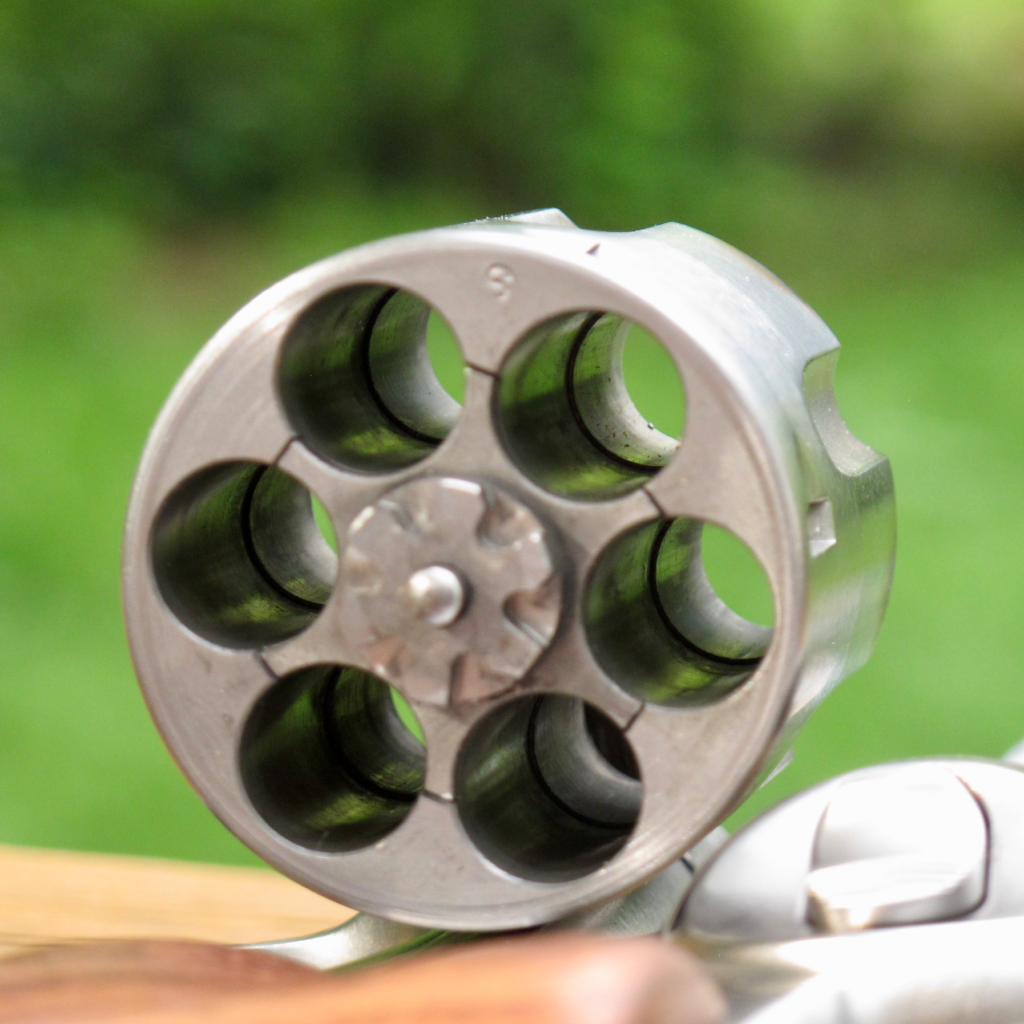
Of course shooting without moon clips only works with 10mm Auto ammo. Other, same-diameter cartridges will fit in the chamber but won’t headspace correctly. Being a hair over .13″ shorter than a 10mm case, the .40 S&W would drop too far into the cylinder to make contact with the firing pin (conversely, 10mm Magnum would also fit†, but would stick out way to far for the cylinder to close). Theoretically moon clips should prevent the .40 cases from slipping too far into the cylinder.
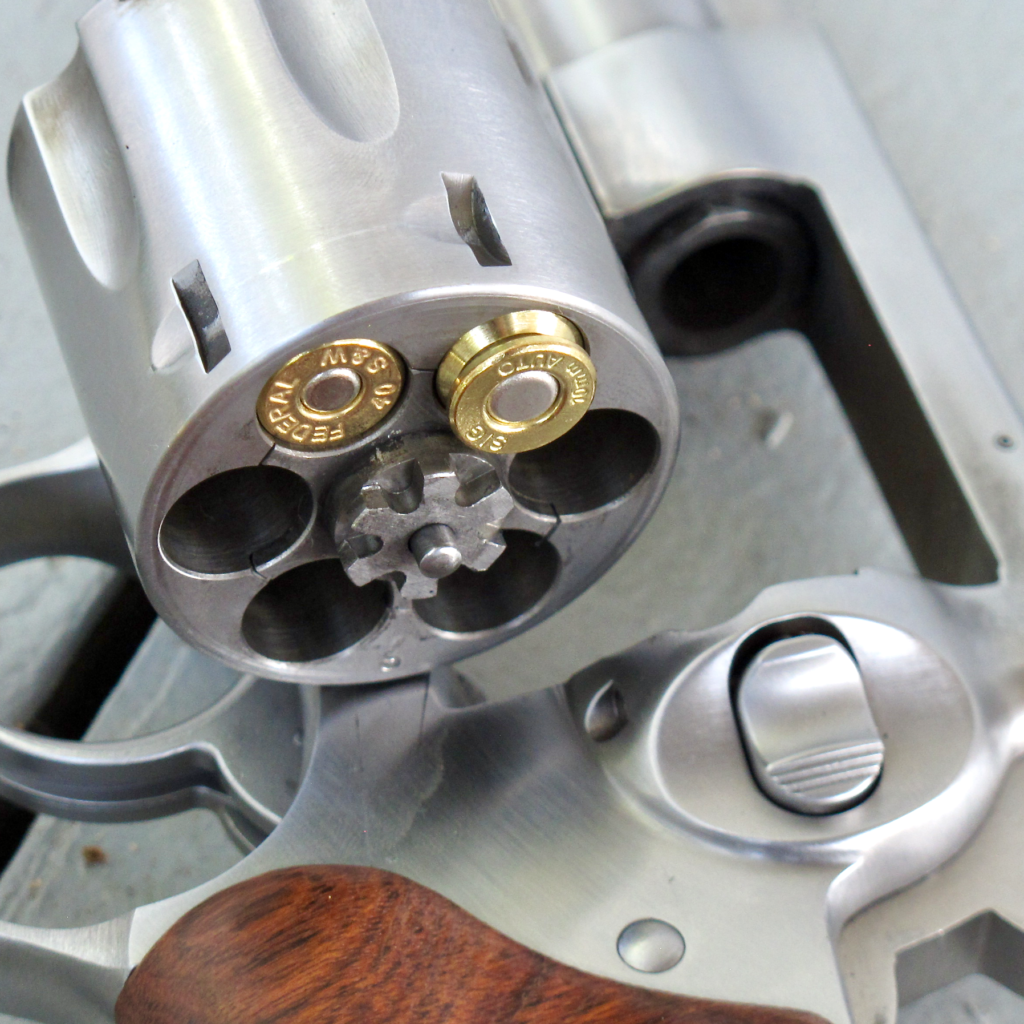
in Practice: .40 S&W in the 10mm GP100
With all those benefits in mind I was pretty stoked on the idea of shooting some .40 S&W in the 10mm GP100. I was mostly interested just for the novelty of it – I am a 10mm man, after all! I was to be disappointed. While at Mike Seeklander’s Handgun Competition Course I passed the GP100 to Mark, a State Trooper and man who knows his revolvers. Mark offered to give me a few .40 S&W rounds from his Glock. He put a few in a moon clip and sighted in the gun. The first BANG! was followed by a very loud “click.” And another, and another before the gun finally went BANG! again.
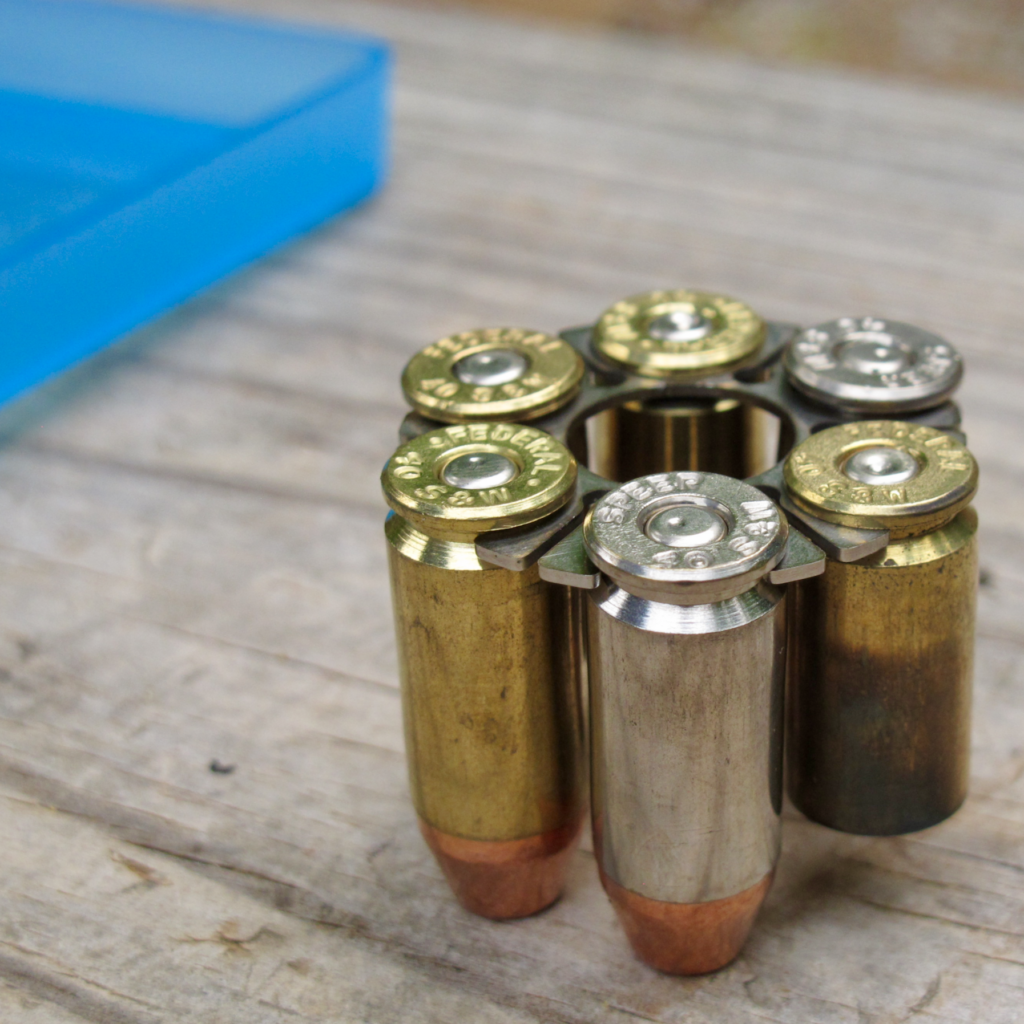
Mark ejected the clip and we took a look at the cartridges. Two cases, and a bunch of very, very light strikes. Just to verify it was the gun and not the ammo, Mark unloaded the moon clip and transferred the rounds directly to a Glock magazine. Every single one worked as intended, so we ruled out ammo as the issue.
To be honest, I was only a little surprised by this. The 10mm cases are held pretty high in the cylinder. So much so that moon clips are sort of “free floating” within the extraction grooves in the cases. Moon clips provide no support at all for the 10mm cartridge in this revolver so I had some nagging doubt about their ability to properly support the shorter cases. Still not ready to be defeated, and smart enough to know what I don’t know, I contacted Tom at TK Custom, a manufacturer of exceptionally good moon clips.
Take 2 with the .40
Tom was happy to talk to me. He thought the issue was the OEM moon clips. If you take a look at them, there is a cut between each cartridge notch. That is on purpose, and its intent is to make the clip loadable and unloadable without the aid of tools. That part of the design works beautifully – the clip is easy to load and unload. Tom thought that the clips might not provide quite enough support for the shorter .40 cases, which aren’t long enough to headspace off the case mouth as the 10mm Auto does, so he shipped me out a set of his clips.
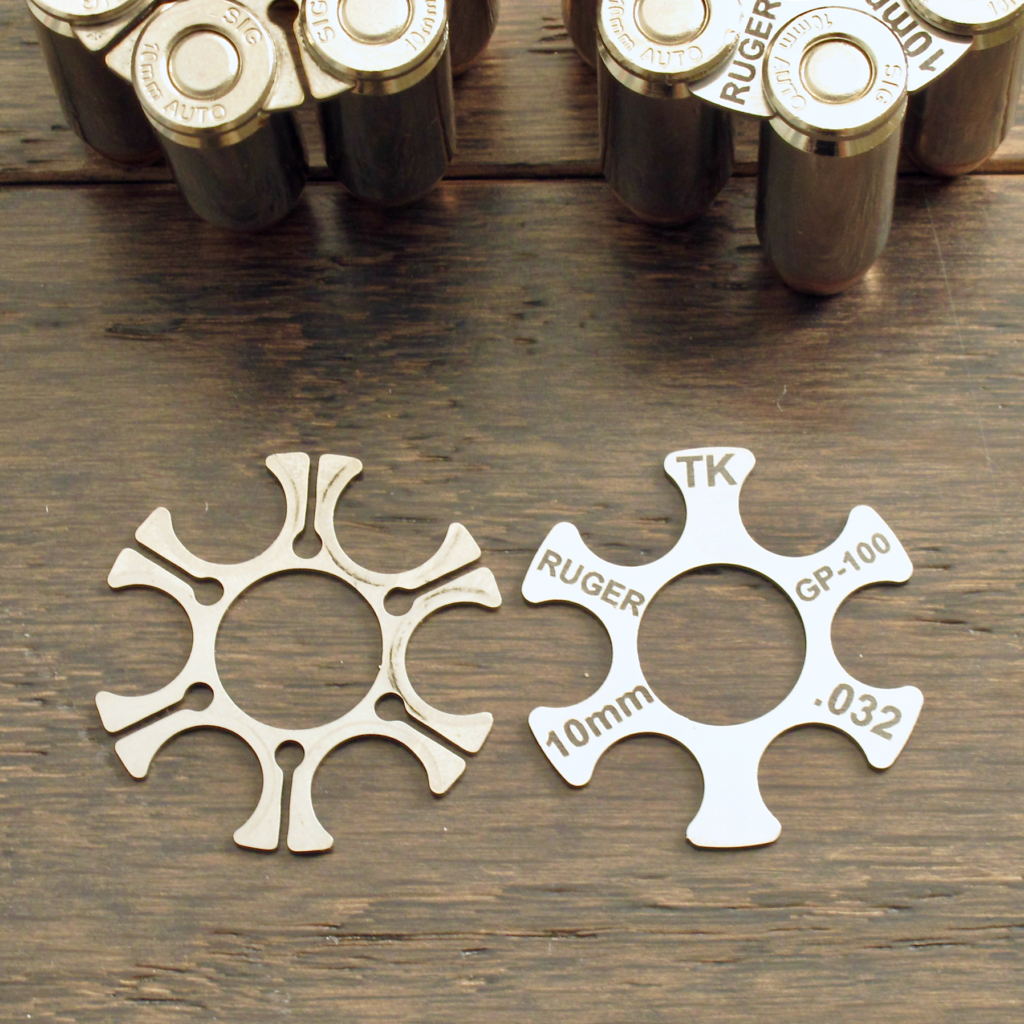
I’ll address both the clips and TK Custom’s moon clip loader and unloader in a future article, but rest assured, they are top of the line. Outfitted with my new clips, I headed to the range and, for the first time in my entire life, purchased a box of .40 S&W ammunition. I quickly loaded up six and threw it in the revolver. Much to my dismay I had the exact same results. Two rounds of the six fired. Though I didn’t take photos, the primer strikes were deeper than those observed previously, but not enough to ensure reliable ignition.
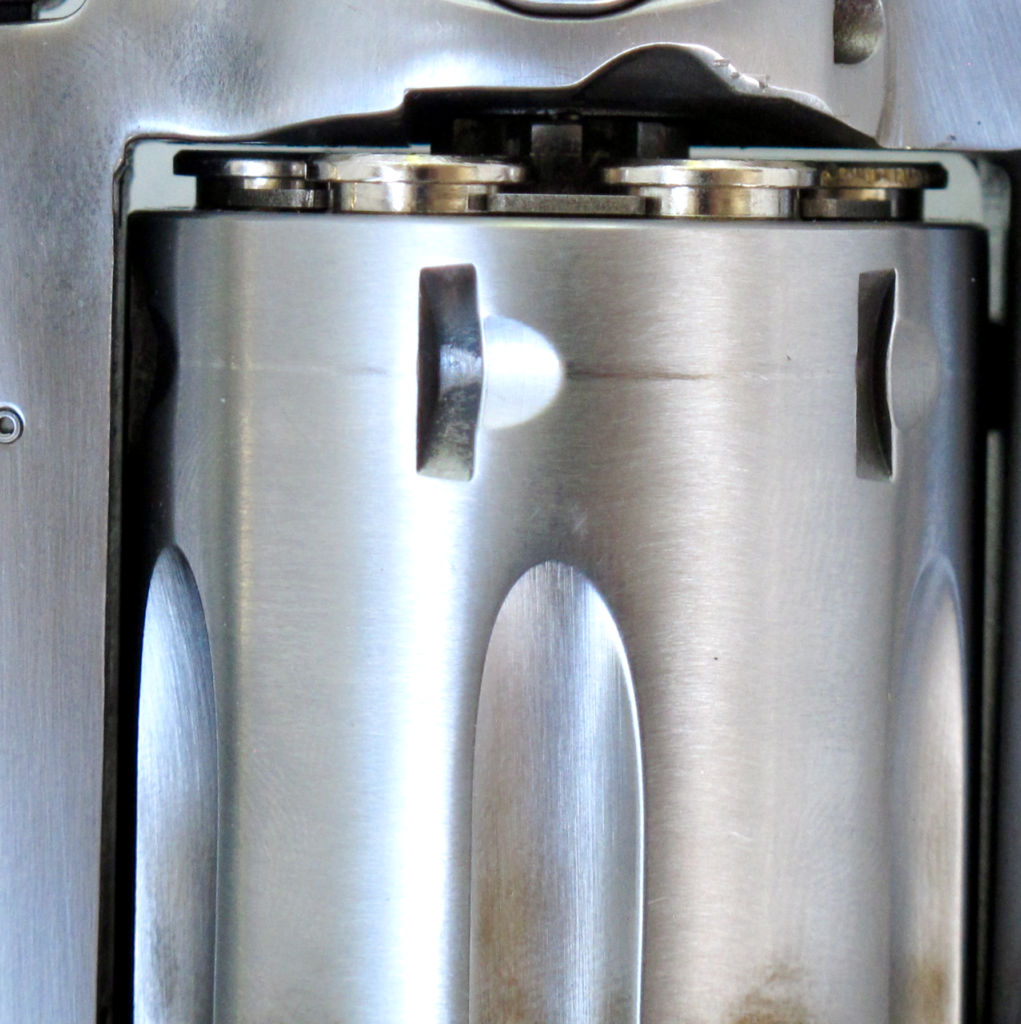
I reported my results to Tom. He asked me to measure the headspace of the 10mm Auto cartridge, and a .40 S&W cartridge, both in moon clips. The difference was pretty stark. With the longer (and correctly headspaced 10mm Auto) I measured a distance from primer to breach face of .010″. With the .40 S&W this distance was increased to .025″, an increase of 150%. Tom responded with, “We may have to thicken the moon clip. Let me know. We’ll make it work for you & your readers.”
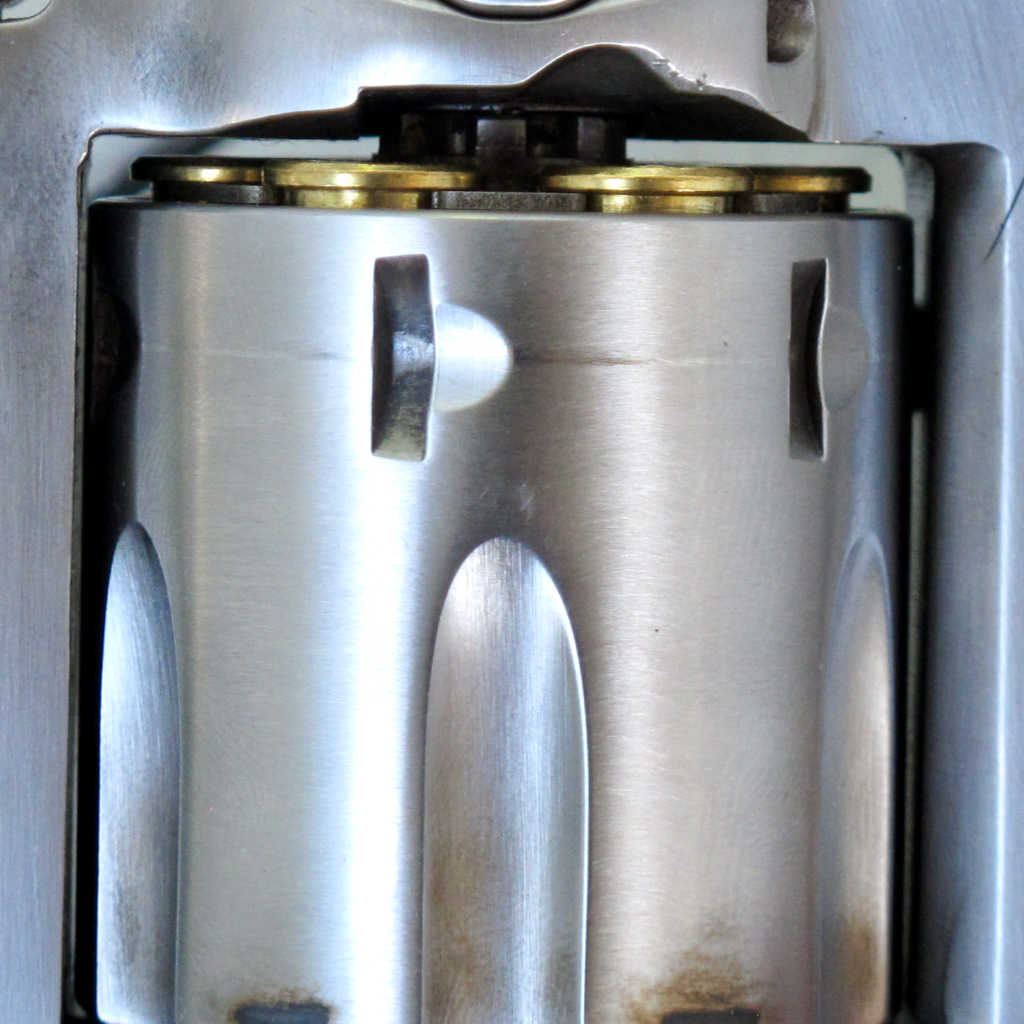
The Bottom Line
I want to be able to shoot .40 S&W in the 10mm GP100 but it isn’t a reality at the moment. Some Match Champion owners have even converted their cylinders to fire 10mm Magnum (10×32). Such a conversion would theoretically allow one to fire the 10mm Magnum as well as 10mm Auto and .40 S&W. One imagines that in practice this would create the same problem with both 10mm Auto and .40 S&W and, at least for now, relegate you to firing only the more boutique cartridge.
It seems to me that a moon clip could be made with some additional shim material left at the center of the clip only. This would serve to raise the .40 primers to the correct height, while leaving the outer portion of the clip narrow enough to fit in the cartridges’ extraction grooves. Now I’m way out of my lane; I have no idea if that’s feasible or what would go into manufacturing such a product. In the meantime I will refrain from shooting .40 S&W in the 10mm GP100 and be content with using standard 10mm ammo, most of which is loaded near .40 S&W levels anyhow. If you’re thinking of buying the new Ruger for use with .40 ammo, you might hold off until a workable solution is in.
†If the 10mm Magnum interests you, this revolver is an excellent conversion candidate!

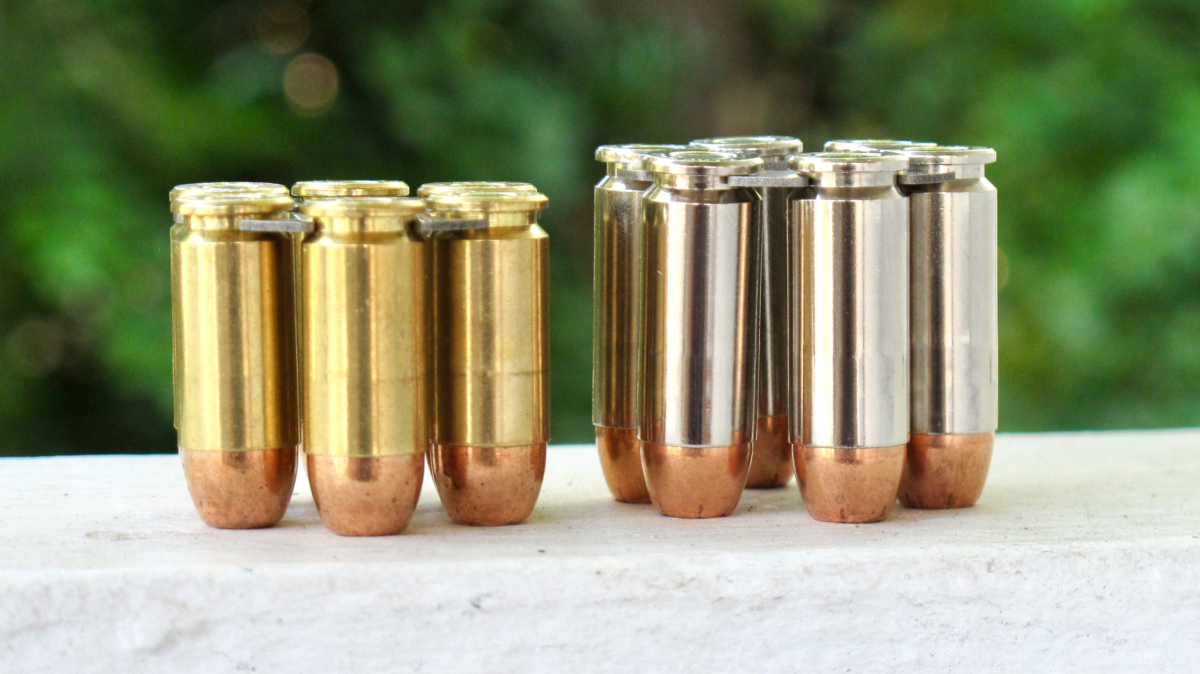
Best. Blog. Ever.
Justin,
I’m not sure this is a valid concern but I wonder: if the cartridge head spaces on the case mouth and .40 isn’t long enough to reach that shoulder, might a bullet strike the shoulder while slightly askew and damage it? I suspect it’s comparable to a bullet jumping cylinder gap to enter the forcing cone, so no, but it might be worth asking Ruger about to be safe.
Rileyguy,
It is possible to get some bullet shaving from the shoulder. I don’t think it would be askew enough to damage it the shoulder itself, but it certainly wouldn’t help accuracy.
I will reach out to a few folks and see if I can get a solid answer on that.
Justin
My suspicion is that the bullet is not the primary concern. Lead and copper are much softer than steel, so there wouldn’t be much risk of mechanical abrasion. I think the more significant concern would be the hot, high pressure gases doing some flame cutting. This would be akin to shooting .38 Spl in a .357 Mag cylinder, but remember that the .38 Spl +P is a 20K psi cartridge, compared to the .40 S&W at 35K psi. In a heavily fouled cylinder, lead and copper deposits at the shoulder could cause some accuracy or pressure issues, possibly. You’ll note that .38 Spl usually shoots more accurately from a .38 Spl cylinder, vice .357….
True enough! However I doubt very many shooters would shoot enough .40 loads at or near the pressure ceiling to make much difference. If you want hot ammo, well, you have that 10mm chamber there…
I think lightly loaded bulk ammo (of the sort you’d fire in competition) would be fine. Then again, I’m not an engineer, and there’s probably a reason Ruger lists the caliber only as “10mm Auto” rather than “10mm/.40 S&W”!
Completely agree! As long as you didn’t let any buildup happen, I don’t think us mere mortals would ever shoot enough .40 in that gun to irreparably damage the cylinder . . . and if we did, we could use the money saved on buying .40 (instead of 10mm) on a new cylinder . . . or gun!
Military Arms Channel on YouTube couldn’t reproduce the results? I find one interesting; why write a blog about this? Make a video! Let’s see the results with our own eyes.
Why write a blog about it, Ray Ray? Hmmm . . . maybe . . . because this is a blog, and not a YT channel?
I’m very happy that MAC’s gun ran like that for him. Actually, I wish all of them would, but our sample doesn’t for some reason. There’s a lot of variables that could account for the different outcomes.
Consider:
1. Two different guns, so two different sets of tolerances. Anybody who’s ever owned two of anything—-whether it’s guns, cars, boots, or can openers—-knows that each has its own quirks and personality. If your gun is the last one made in a production run before they change out the tool head, you’re gonna have a different set of tolerances than the next one made. That’s why all manufacturing specs have ranges, and it’s why stacking tolerances can create problems, even when all the parts are technically “in spec.” Every gun is a sample size of one;
2. Not only are we talking two different guns, we’re talking two different models. One is a MC, the other a WC. Did Ruger change something between the models? Who knows. A different spring, bushing, or other part can make a big difference, and so can a little extra attention to polishing or fitting, as you might find on a special edition model like the Wiley Clapp GP;
3. Different ammo. MAC shot Federal Syntech, which has a lead free primer. It’s well known in the industry that lead free primers have different characteristics than those that use lead styphnate in the compound. Justin did not shoot lead free ammo in his testing, so this is an important variable to account for when the question is ignition reliability.
In the end, Justin accurately reported what happened with his gun, and MAC accurately reported what happened with their gun. The fact that the two outcomes were different is interesting, but perhaps not surprising, and it’s certainly not a sign that anybody is being deceptive or trying to hide something. It is what it is.
We’re happy to see that MAC was able to shoot .40 S&W with reliability in their gun, and we hope all of our readers have a similar experience to theirs. Justin has spent a lot of time and money trying to get his gun to perform like MAC’s did straight out of the box, but he’s still not there (and he’s still working with vendors to figure it out). I’m sure he would have been thrilled to get the same result MAC did, but he didn’t.
Instead of questioning his integrity, and asking for video evidence as “proof,” perhaps you should consider that Justin had nothing to gain by reporting the problem, and everything to lose. He ran the risk of upsetting both Ruger and TK Custom by criticizing their products in print, but there was no corresponding gain, other than the satisfaction of being honest with his readers.
You might also consider that several readers have reported similar misfires right here in the comments to this article, so it’s not Justin alone who’s making the claim.
I’ve been in this industry for a while and have seen what’s going on behind the curtains in many operations. I can tell you that the biggest threat to the consumer is not that someone will create and report a fake problem, but that they will hide a real one.
We don’t do that here at RG. We report what happens, even when we, or someone else, might not like the answer. I think that makes us different than a lot of places, particularly on the “errornet.”
We wish MAC well and hope their gun will keep shooting without a hitch. In the meantime, we’ll honestly report what’s going on with ours. Thanks for reading.
All excellent points, thanks.
I don’t think I had this problem in my S&W610 but has been a while since I have shot it
I have shot thousands of rounds of .40 S&W from a 10mm S&W 610 in USPSA competition without a hitch. I bought the GP100 10mm before I saw the rather weak disclaimer in the manual about the use of .40 S&W ammo. The problem is excessive headspace when using .40s head spacing off the clips.
Besides the .032″ thick Ruger clips, I tried S&W 646 clips which are .035″ thick and also Chiappa Rhino clips at .039″ thick. They were all failures, the worst being the Ruger. If TK made clips they would have to be about .046″ thick, and hopefully fit in the extraction groove. Ruger could solve this and make the cylinders longer to the rear.
Rich I’d agree, somewhere around 0.045″ would probably work reliably with most primers. I think part of the problem is moonclips that are used to headspace like for the 40 S&W tend to absorb hammer energy so all things being equal you need more kinetic energy in the hammer. I’ve removed as much material off the top of the hammer as I can to maximize static firing pin protrusion and I’m still having light primer strikes with CCI and magnum primers mostly in double action with the tkcustoms 0.040″ moonclips. I’m experimenting with adding shims to the hammer spring to increase kinetic energy of hammer however double action trigger pull is getting tough.
Thanks for posting – I haven’t seen this information anywhere else, including in several magazine articles discussing the gun.
Bummer about the results, though; a .40 S&W-compatible revolver would be so much more useful.
I would prefer a gun that would use both since it would give me a little more ammo versatility. I imagine the extent to which any individual shooter is bothered by this depends on his or her use case. Personally, I can live with it. I will mainly use this gun with 10mm Auto tipped with heavier JHPs and hard cast lead. The 10mm GP fits into my lineup mostly as hunting and range gun. I can see how competitors would be put off by this but for most of us who want a defense/hunting/range gun, I wouldn’t worry about it too much.
Thanks for another great article. When this gun first came out I thought it would be a great gun for IDPA REV division, esp with .40 instead of 10mm, for all the advantages you mentioned (plus, the shorter rounds make it faster to reload with .40’s). I have shot matches with my S&W 66-2 and speedloaders, but the longer reload times, compared to moon clips, just killed by scores. There is just no comparison. The other option is to go to the S&W 625 but I have smallish hands and just can’t shoot N frames well in rapid fire. I thought a GP 100 in 10mm, shooting .40, would make the power factor, offer fast reloads, and fit my hand well. I guess I will sit this one out for now, and see if Ruger addresses the problem.
Best,
Paul
It might still be a great competition gun…Tom from TK Custom is sending me out some thicker moon clips as we speak, which may correct the issue. Being more defense- and field-oriented, I like how Ruger setup the cylinder on this model. There is enough brass protruding from the cylinder that you can pull each piece out by hand if you are shooting without the aid of moon clips.
Good point, and looking forward to hearing how the new clips work. I like guns that can do several jobs well and this one looks like a great all-around revolver–home defense, range use, field use (I live in the Southeastern US and the 10mm will handle anything that walks or crawls in this part of the country) and competition would be a nice add-on.
Best,
Paul
I’d use .40 for practice, but I guess not in this gun! It wouldn’t put me off buying it, but it does lose a little flavor for me…
My first visit to this great site.
My concern would be with the case support that us reloaders run into, commonly known as the glock bulge. Could you experience a case blowout with the wider moon clip?
I don’t believe case bulging would be a problem here. I’ll qualify that with the following: I’m not a reloader but I’ve shot a lot of really heavy 10mm through the gun. The wider clips would only hold .40 S&W ammo to the “normal” height that 10mm is held. Again, I’m not an expert but I don’t think it would be a problem.
From my experience and estimate no. There should still be plenty of support. But each situation may be different. I find a lot of probs lately with 40 not feeding reliably but im shooting in multiple barrels and this gp100 now. I often deglock 40 and 10 brass with grx redding push through die every few firings usually even though i use after market bbls in glock . also somebody elses range brass gets mixed in im sure too. Heard good things about Lee factory crimp die too so going to check that out. Id avoid hot loading old brass though.
The .40 S&W and 10mm cases have the same SAAMI specifications for the rim, extractor groove, and extractor groove bevel.
The photos show that the web of the 10mm case is fully-supported when headspaced off of the casemouth. In fact, the start of the extractor groove bevel is slightly below the mouth of the chamber.
As Justin’s revolver does not display excessive headspace with the 10mm cartridge, it stands to reason that any moonclip that could cause the .40 S&W case to be unsupported would probably be so thick that the cylinder could not close.
0.050″ moonclips are the practical maximum thickness allowed by the specifications for the cases’ extractor groove. In fact, any clip thicker than 0.045″ may interfere with the case bevel.
I guess it’s only peripheral to the primary focus of this article, but there seem to be a lot of people out there who are convinced that 10mm is clearly and vastly superior to the .40, that .40 is the “short and weak” version of 10mm, etc, etc…
For those folks, I’ll just put this here. One again, Paul Harrell provides some good food for thought, if not some mythbusting:
https://www.youtube.com/watch?v=ydwXJ2yhfnU
Absolutely. The most important thing when comparing 10 and 40 is load selection. There is indeed plenty of 10mm ammunition that mimics .40 S&W ballistics, and if you’re not paying attention to what you feed your gun, you’ll be getting no advantage from the 10mm.
Having said that, the 10mm dramatically outperforms the .40 S&W when the right loads are chosen. Justin has been doing a bunch of testing and will have much more to say on this subject in these pages soon.
Thanks, Mike. And yeah, I think that’s the whole point Harrell was trying to make as well
– 10mm CAN outperform .40 for sure, but it doesn’t automatically do so with just any load you grab off the shelf. Looking forward to seeing those test results!
I wonder if the RIMZ polymer moon clips for the S&W Model 646 might be thick enough to help. I seem to remember reviews stating that their clips were thicker than standard metal moon clips.
TK Custom now has the .40 S&W Moon Clip in .040 Thickness to remedy the ignition issue in the GP-100 10mm Revolver.
Link: https://www.tkcustom.com/products/ruger-gp-40sw
The .040″ TK Moonclips for 40S&W still have light strike issues due to excessive headspace when used with 40 s&W in the GP100 10mm. Clip thickness needs to be closer to 0.046-0.050″ to prevent excessive headspace. Thickness of the rim on 40 S&W and 10mm is the same, so a moon clip that provides prefect headspace for the 40 S&W will also work with 10mm, it just means in 10mm it headspaces off the moon clip simultaneously to headspacing off off the 10mm case mouth.
Agreed. I have some .040″ TK clips, and can’t get .40 S&W to ignite reliably.
We have made some .050 thick moon clips for evaluation.
Sending samples out to Justin.
https://www.tkcustom.com/products/ruger-gp-40sw-050
We are getting the metal to make the .40 S&W moon clips in .050 thickness. From all the comments & emails this looks to be the solution? Will keep everyone informed.
Tom It would be great if .050 clips could have relief cuts to make loading and unloading easier.
Took my new GP100 10MM with 5″ barrel to the range this afternoon and to my dismay it would not fire 40 S&W ammo reliably. Wish I had seen this post sooner and had been aware of this fact. I would definitely like to get my hands on some of the thicker moon clips. I imagine that they will be considerably more difficult to load and unload but if they solve the issue I could certainly live with it. My measurements indicated that a thicker moon clip would likely need to be at least 15 thousands of an inch thicker than the factory Ruger moon clip to allow the 40 S&W to fire reliably. The 5″ model did demonstrate good accuracy potential with both 10MM and 40 S&W ammo.
Keep an eye out. I have an update on this issue coming soon!
I think maybe a dimple could be punched into the moon clips between each cartridge head and might give the extra “lift” needed. cheap relatively easy fix just need a rounded nosed center punch and a “anvil with a little dimple drilled into it and some way of indexing to know where to punch.
Ooh, I like that idea James. I think you’ve got something there!
Has anyone watched the video that MAC posted today? He had absolutely no problems firing a hundred + rounds of .40 in his revolver today. https://youtu.be/IGUJEkWPqEk
Thanks for pointing that out, Chris. I hadn’t seen this, but I yesterday I did see Hickok45 shoot a GP100 with .40 with no problems. A couple thoughts.
First, since I only have a sample size of one it is possible that the tolerances of my revolver are much looser than those of others. I got a very early model, so it’s entirely possible, but it seems Ruger had the same issue. My contact there stated, “Thanks Justin. We tried the .40S&W extensively, some brands work, some don’t, lots of light strikes.”
Second, Tim is using a slightly different model of the GP100. The model he uses is the 3″ TALO exclusive edition (this also appears to be the model Hickok45 uses). I didn’t think this would make a difference, but it’s also hard to believe these guns could have such wide tolerances. I’m honestly not sure what to attribute this to.
The space between recoil shield and cylinder looks shorter then mine on some. Mine is spacious at about .11″. I think primer protrution is supposed to be around .050″. So .050″ clips should do the job or get much closer. I also installed bowen extended firing pin but it only gave me another .010″ more protrution after fitting it so it did not extent out of recoil shield. Bowen did provide new firing pin spring which was flat ground unlike the ruger original so firing pin operation is much smoother. Have not tested it much but still had some light strikes in double action with cci primers (very hard) and the tk .040 clips. I think we fighting a slighly reduced hammer spring on match champion too so i put in an old ruger hammer spring but need to test more. It would be great if .050 clips could have relief cuts to make loading and unloading easier.
J,
I am going to do a full post on this but… Tom did send me .050 moon clips. The results were extremely encouraging, but there are still a couple problems (relief cuts, as you mention, are strongly desired on clips this thick!). Tom has the gun on its way back to me. We’ll see what happens!
Justin
Justin – I’m beginning to thick that the only solution to your .40 S&W light strikes is going to be either: a new extractor or a modification of the existing extractor. As far as potential modifications, I picture two options. One would be silver soldering a ~0.025″ shim to the rear of the extractor and trimming off any excess. (For shim material, you could probably use a factory moonclip!) The other would involve a laser welder adding material to the rear of the extractor which could then be milled to an appropriate thickness.
Frankly, it would be better if Ruger redesigned the cylinder and extractor themselves. A 10mm cylinder lengthened at the rear would have an added practical benefit as it would allow for beveling the chamber mouths without affecting the support of the case.
FWIW: Judging from the fouling pattern on the breechface pictured in another section of your review, it kind of looks like the firing pin is hitting off-center. It isn’t an issue with the large primer of the 10mm, but perhaps it is far enough off center to cause an ignition issue with the small primer of the .40 S&W? Perhaps you could double-check this possibility by testing a small primer 10mm case like the Federal non-toxic load or CCI-Blazer?